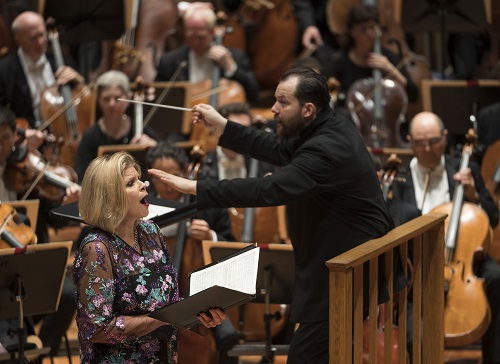
 Germany Musikfest Berlin 2018 [4] – Mahler: Susan Graham (mezzo-soprano), GewandhausKinderchor, Damen des GewandhausChores, Boston Symphony Orchestra / Andris Nelsons (conductor), Philharmonie, Berlin, 6.9.2018 (MC)
Germany Musikfest Berlin 2018 [4] – Mahler: Susan Graham (mezzo-soprano), GewandhausKinderchor, Damen des GewandhausChores, Boston Symphony Orchestra / Andris Nelsons (conductor), Philharmonie, Berlin, 6.9.2018 (MC)

Mahler – Symphony No.3 in D minor
The Boston Symphony Orchestra coming to town is a big event, especially when the work programmed is Mahler’s Third Symphony, a colossal work that embodies the composer’s epoch-making concept of the symphonic form.
A paean to nature created by God is embodied in Mahler’s Third Symphony and his belief that the world, through nature and God, can be made a better place continues to inspire people today. Requiring massive orchestral forces, the Third Symphony is one of the supreme and towering creations in classical music. It is Mahler’s longest symphony and it often felt like it with Nelsons stretching the work out as he did here. Composed in 1893-96, mainly during summer holidays at Steinbach am Attersee close to Salzburg, Mahler’s Third Symphony is his view of the vast natural world, a subject that was an enduring passion for the composer throughout his life. Mahler said the Third was “one great hymn to the glory of every aspect of creation.” Major influences were the philosophy of Friedrich Nietzsche’s Thus Spoke Zarathustra and the collection of German folk poems Des Knaben Wunderhorn (The Youth’s Magic Horn). The symphony evolved as a seven-movement score, however, the work’s final structure is six movements divided into two parts. The first part is a single movement and part two has five movements. On the handwritten manuscript Mahler gave titles to each of the movements, to serve as signposts to understanding, but these did not subsequently appear on the printed score.
The first part, a monumental single movement, titled ‘Pan Awakes. Summer Marches In’, opened in a declamatory character with a fanfare from the bank of horns and hammering drum strikes. Mahler created a cornucopia of nature sounds with a prominent sense of stirring, contrasted with an episodic martial character to which Nelsons and his Boston players responded with substantial vigour and often impassioned orchestral splendour. The extended solos for the principal trombone were totally captivating, providing me with unmistakable martial associations probably reflecting the military music Mahler heard during his youth at a local barracks. In addition, I enjoyed seeing the percussionists dashing off-stage to play their snare drums
Titled ‘What the Flowers in the Meadow Tell Me’, the second movement (the first movement of Part Two) takes the form of a minuet and Nelsons and his players revelled in such wonderful joyous writing with its prevailingly refined disposition. It really did feel like looking out on a flower strewn Alpine meadow, such a familiar and treasurable scene for Mahler. In the Scherzo movement three, ‘What the Animals in the Forest Tell Me’, Mahler draws on his song Ablösung im Sommer (Relief in Summer; Changing of Summer) from Des Knaben Wunderhorn. In Nelson’s hands the music felt clearly like a tone poem portraying the transformation in the forest from day into night. Positioned out of sight somewhere up in the gallery the trumpeter, playing what sounded like a flugelhorn, was in outstanding form with this extended and challenging part which is so exposed. Titled ‘What Man Tells Me’, movement four (with its solo alto part) is a setting of Zarathustra’s Midnight Song that begins ‘O man! Take heed/care!’ from Nietzsche’s philosophical novel Also sprach Zarathustra over a rocking orchestral rhythm. Giving a haunting rendition of significant intimacy was the immaculately dressed star Susan Graham. With her quietly assured manner the American mezzo-soprano displayed her smooth, creamy voice to significant effect, creating a sensual atmosphere. Upbeat and agreeably boisterous, the short fifth movement titled ‘What Angels Tell Me’ included choruses of women and children with soloist Susan Graham again singing text from Des Knaben Wunderhorn. There was inspiring singing from the impeccably prepared GewandhausKinderchor, comprised of around two-thirds girls and one-third boys, and Damen des GewandhausChores that communicated warm sincerity. The Finale, a considerable Adagio with the title ‘What Love Tells Me’ is aptly described by Philip Barford in his BBC Music Guide – Mahler Symphonies and Song as “a flood of glorious music [which] majestically unfolds a magnificent paean of love.” Wholeheartedly committed and intense, this was a riveting account from Nelsons and his Boston players, an interpretation of considerable spirituality with the conclusion culminating in a remarkable apotheosis.
Taking a firm grasp on the proceedings, Nelsons’ captivating interpretation was paced with tempos that generally felt on the slow side, even laboured at times. The Boston orchestra delivered the music with unerring concentration and a significant depth of expression. I relished the lovely body to the string sound and I doubt that basses have ever worked as hard, while the expressive woodwind and magnificent brass maintained the orchestra’s reputation for excellence with credit. This was a gloriously played interpretation of passion and drama from Nelsons that also felt high on sincerity with a sense of total engagement. How the children’s choir managed to sit still for so very long remains a mystery. A minor grumble was the surprising decision not to use the surtitle screens for the sung texts including English translations.
Nelsons presided over a quite magnificent performance of this awe-inspiring work and all the plaudits were unquestionably deserved.
Michael Cookson